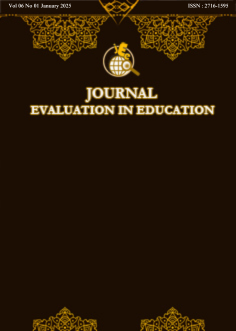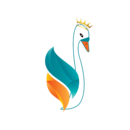Integrated Volume Card Game Make A Match Learning Model: Improving Motivation of Learning Outcomes of the Concept of Spatial Building
Abstract
Purpose of the study: This study aims to design, develop, and evaluate the effectiveness of an innovative interactive learning medium, a volume card game integrated with the Make a Match cooperative learning model, to enhance students' conceptual understanding of volume in mathematics.
Methodology: Using an ADDIE model (Analysis, Design, Development, Implementation, Evaluation). Data collection tools included pretest-posttest questionnaires, expert validation sheets, and N-Gain analysis to assess the media’s validity and learning effectiveness. Statistical analysis, including the Paired Samples T-Test, was conducted using SPSS software.
Main Findings: The findings revealed that the volume card game achieved a high validity score of 91% according to expert evaluations, indicating that it is well-suited for classroom use. Furthermore, the game significantly improved student learning outcomes, as evidenced by the Paired Samples T-Test results (p = 0.000) and an N-Gain score of 0.7575, which falls in the high category. Positive feedback was overwhelming, with 98.6% of students reporting that the game was engaging, enjoyable, and effective in fostering their understanding of volume concepts.
Novelty/Originality of this study: This study introduces an innovative combination of interactive learning tools and cooperative learning strategies, addressing the challenges of teaching abstract mathematical concepts. By merging gamification with collaborative learning, the volume card game provides an engaging and practical approach to enhance motivation and deepen conceptual understanding. The novelty of this research lies in its dual focus on integrating educational games with cooperative learning and demonstrating its scalable potential for application in broader mathematical topics and academic contexts.
References
Republic of Indonesia Law No. 20 of 2003 on the National Education System.
M. Nainggolan., et al., “The effect of the SAVI learning model on the mathematics learning outcomes of elementary school students,” Jurnal Basicedu, vol. 5, no. 4, pp. 2619, 2021, doi: 10.31004/basicedu.v5i4.1235.
D. Maharani, and S. Nugroho, “Improving mathematics learning outcomes on solid figures using cube and rectangular prism teaching aids,” Journal of Mathematics Education and Mathematics, vol. 3, no. 1, pp. 10-20, 2020.
N. Hidayah, A. Azhari, and S. Subhan, “Implementing constructivist learning to enhance student engagement through interactive media,” Journal of Education and Learning, vol. 18, no. 1, pp. 32-42, 2023.
L. Curran, “Cooperative learning model: Make a match,” Islamic Pedagogy: Journal of Islamic Education, vol. 1, no. 2, 2021.
S. Suhono, The Use of the Make a Match Learning Model to Improve Motivation and Learning Outcomes in Human Reproductive System, Surakarta: Unisri Press, 2022.
M. Hosnan, Scientific and Contextual Approaches in 21st Century Learning. Jakarta: Ghalia Indonesia, 2023.
T. Trianto, Integrated Learning Models in Theory and Practice. Jakarta: Bumi Aksara, 2024.
M. S. Rumetna, T. N. Lina, and A. B. Santoso, “Design and development of a savings and loan cooperative application using research and development method,” Simetris: Journal of Mechanical Engineering, Electrical Engineering, and Computer Science, vol. 11, no. 1, pp. 119–128, 2020.
Rayanto, Y. H. Research and Development of ADDIE and R2D2 Models: Theory & Practice. Academic Institute & Research Institute, 2020.
R. M. Branch, Instructional design: The ADDIE approach, in Encyclopedia of Evolutionary Psychological Science, New York: Springer, 2009, doi: 10.1007/978-3-319-19650-3_2438.
I. Ghozali, Application of Multivariate Analysis Using IBM SPSS 26, Semarang: Universitas Diponegoro Press, 2021.
H. R. Rahmaputri, “Interactive educational game media in mathematics learning,” Journal of Education Research, vol. 5, no. 4, pp. 4382-4390, 2023.
J. Gosachi, “The make a match cooperative learning model assisted by picture cards to improve mathematics learning outcomes,” Mimbar PGSD Undiksha, vol. 3, no. 2, pp. 152-163, 2020.
M. H. Al Abri, A. Y. Al Aamri, and A. M. A. Elhaj, “Enhancing student learning experiences through integrated constructivist pedagogical models,” European Journal of Contemporary Education and E-Learning, vol. 2, no. 1, pp. 130-149, 2024, doi: 10.59324/ejceel.2024.2(1).11.
V. Lakshmi, P. Dass, B. Srivalli, and T. Ugandhar, “Enhancing learning outcomes in social sciences through the integration of research-based teaching strategies,” International Research Journal on Advanced Engineering and Management (IRJAEM), vol. 2, no. 3, pp. 516-527, 2024, doi: 10.47392/IRJAEM.2024.0072.
S. Kharroubi, and A. ElMediouni, “Conceptual review: Cultivating learner autonomy through self-directed learning & self-regulated learning: A Socio-Constructivist exploration,” International Journal of Language and Literary Studies, vol. 6, no. 2, pp. 276-296, 2024, doi: 10.36892/ijlls.v6i2.1649.
S. Mbise, and C. Lekule, “Strategies for Promoting the Practice of Constructivist Teaching and Learning Process in Tanzanian Schools,” East African Journal of Education Studies, vol. 6, no. 3, pp. 226-240, 2023, doi: 10.37284/eajes.6.3.1544.
Aithal, P. S., & Mishra, N. (2024). Integrated framework for experiential learning: Approaches & Impacts. International Journal of Case Studies in Business, IT and Education (IJCSBE), 8(1), 145-173, 2024, doi: 10.47992/IJCSBE.2581.6942.0340.
V. Mastura, A. Arjudin, and A. Fauzi, “The effectiveness of the make a match cooperative learning model on the mathematics learning outcomes of fourth grade students at SDN 1 Ampenan,” Journal of Mathematics Education, vol. 6, no. 4, pp. 4382-4390, 2024.
D. Cañabate, R. Bubnys, L. Nogué, L. Martínez-Mínguez, C. Nieva, and J. Colomer, “Cooperative learning to reduce inequalities: Instructional approaches and dimensions,” Sustainability, vol. 13, no. 18, pp. 10234, 2021, doi: 10.3390/su131810234.
M. R. Ridwan, and S. Hadi, “A meta-analysis study on the effectiveness of a cooperative learning model on vocational high school students’ mathematics learning outcomes,” Participatory Educational Research, vol. 9, no. 4, pp. 396-421, 2022, doi: 10.17275/per.22.97.9.4.
J. Nilimaa, “New examination approach for real-world creativity and problem-solving skills in mathematics,” Trends in Higher Education, vol. 2, no. 3, pp. 477-495, 2023, doi: 10.3390/higheredu2030028.
L. D. Lapitan Jr, A. L. A. Chan, N. S. Sabarillo, D. A. G. Sumalinog, and J. M. S. Diaz, “Design, implementation, and evaluation of an online flipped classroom with collaborative learning model in an undergraduate chemical engineering course,” Education for Chemical Engineers, vol. 43, pp. 58-72, 2023, doi: 10.1016/j.ece.2023.01.007.
A. H. S. Dzaiy, and S. A. Abdullah, “The use of active learning strategies to foster effective teaching in higher education institutions,” Zanco Journal of Human Sciences, vol. 28, no. 4, pp. 328-351, 2024, doi: 10.21271/zjhs.28.2.11.
O. T. Adigun, N. Mpofu, and M. C. Maphalala, “Fostering self‐directed learning in blended learning environments: A constructivist perspective in Higher Education,” Higher Education Quarterly, e12572, 2024, doi: 10.1111/hequ.12572.
B. Garner, and N. Shank, “Using adult learning theory to explore student perceptions of the flipped class method,” Journal of Marketing Education, vol. 46, no. 3, pp. 198-213, 2024, doi: 10.1177/02734753231196501.
M. Zamiri, and A. Esmaeili, “Methods and technologies for supporting knowledge sharing within learning communities: A systematic literature review,” Administrative Sciences, vol. 14, no. 1, pp. 17, 2024, doi: 10.3390/admsci14010017.
A. Capatina, D. Juarez-Varon, A. Micu, and A. E. Micu, “Leveling up in corporate training: Unveiling the power of gamification to enhance knowledge retention, knowledge sharing, and job performance,” Journal of Innovation & Knowledge, vol. 9, no. 3, pp. 100530, 2024, doi: 10.1016/j.jik.2024.100530.
C. D. Duong, T. N. Vu, and T. V. N. Ngo, “Applying a modified technology acceptance model to explain higher education students’ usage of ChatGPT: A serial multiple mediation model with knowledge sharing as a moderator,” The International Journal of Management Education, vol. 21, no. 3, pp. 100883, 2023, doi: 10.1016/j.ijme.2023.100883.
D. Wulandari, and A. Lestari, “Learning using interactive game-based media: Quizizz for junior high school students,” Educational Science: Journal of Theoretical and Practical Education, vol. 2, no. 1, pp. 28-37, 2023.
Copyright (c) 2025 Anggun Tri Wahyuni, Yuli Witanto

This work is licensed under a Creative Commons Attribution 4.0 International License.
Authors who publish with this journal agree to the following terms:
- Authors retain copyright and acknowledge that the Integrated Science Education Journal is the first publisher licensed under a Creative Commons Attribution 4.0 International License.
- Authors are able to enter into separate, additional contractual arrangements for the non-exclusive distribution of the journal's published version of the work (e.g., post it to an institutional repository or publish it in a book), with an acknowledgment of its initial publication in this journal.
- Authors are permitted and encouraged to post their work online (e.g., in institutional repositories or on their website) prior to and during the submission process, as it can lead to productive exchanges and earlier and greater citation of published work.









.png)
.png)





